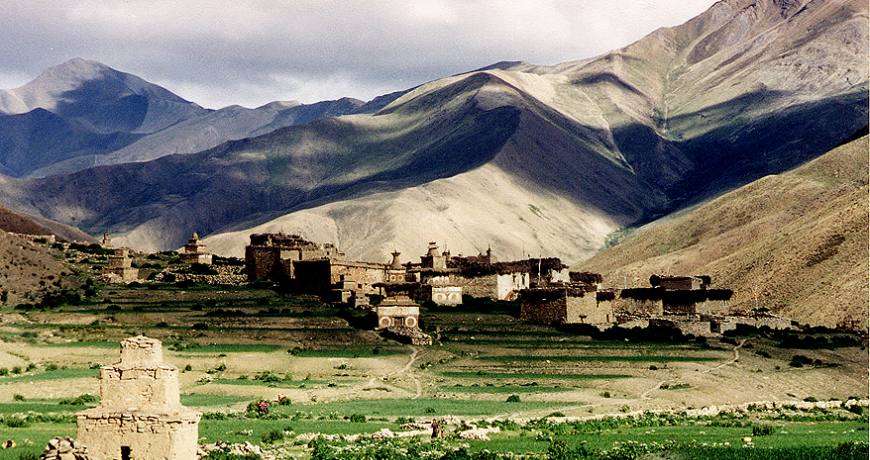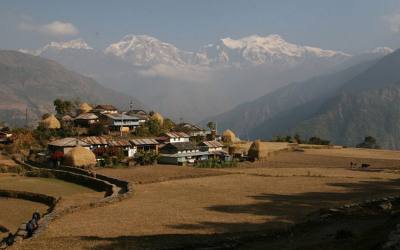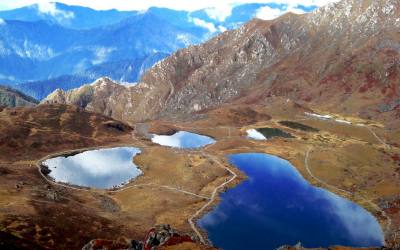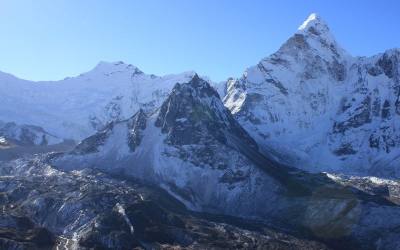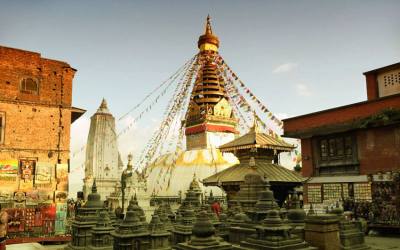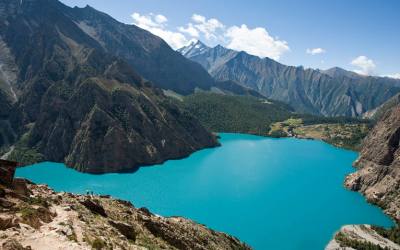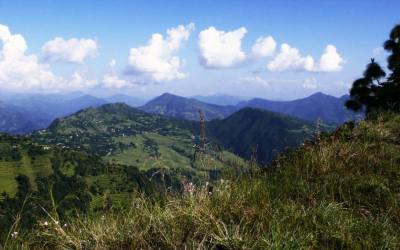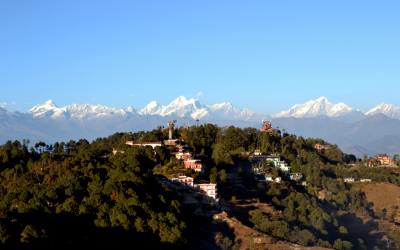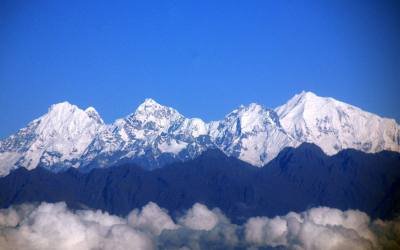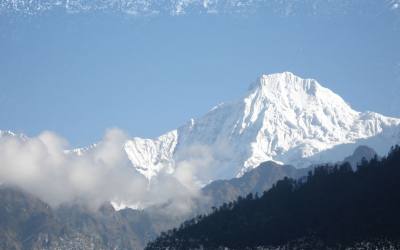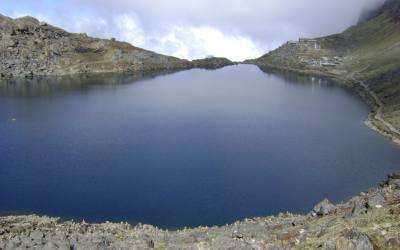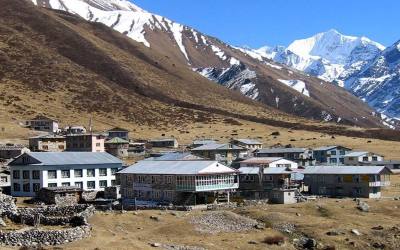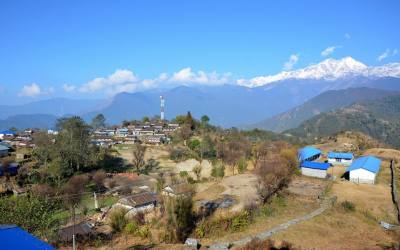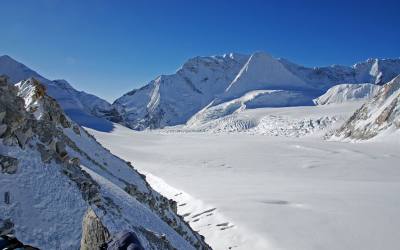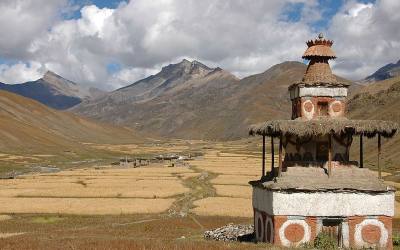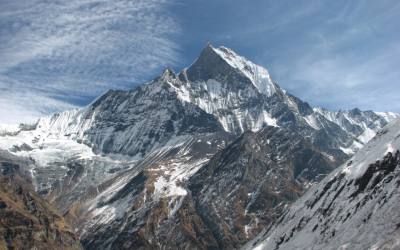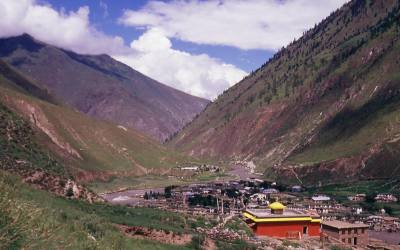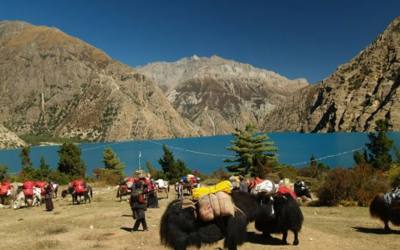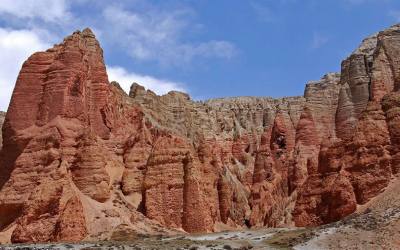The Dolpa Circuit is quite strenuous, with some steep climbs. You have to cross two passes, Numa La of 5318 m and Baga La of 5190 m. These crossings involve long climbs and long descends. But the scenery on the way and the views from the passes are amazing and makes it all worth it.
Leaving from Kathmandu, it’s a 14 days trip, but but it could be longer or shorter, depending on the length of your walking days.
There are guesthouses in Juphal, Dunai, Lingdo, Dho Tarap, Ringmo, close to Sanduwa (next to the Amchi Hospital), Chhepka and Kageni. At the other places you have to camp.
Walking times are of course a guideline and differ from person to person. The times mentioned, are excluding breaks.
Day 01: Flight Kathmandu-Nepalgunj.
Day 02: Flight Nepalgunj-Juphal (2475 m), walk to Dunai (2140 m) 2 ½ hrs
Day 03: Dunai (2140 m) to Lingdo (2391 m) 5 hrs
Day 04: Lingdo (2391 m) to Laina Odar (3370 m) 6 hrs
Day 05: Laina Odar (3370 m) to Nawarpani (3475 m) 4 hrs
Day 06: Nawarpani (3475 m) to Sisaul (3750 m) 3½ hrs
Day 07: Sisaul (3750 m) to Dho Tarap (4080 m) 4 hrs
Day 08: Dho Tarap (3944 m) to Numala Base Camp (4440 m) 3 ½ hrs
Day 09: Numala Base Camp (4440 m) to Danigar (4631 m) via Numa La (Pass) (5318 m) 6 hrs
Day 10: Danigar (4631 m) via Baga La (5190 m) to Yak Kharka (3982 m) 6 hrs
Day 11: Yak Kharka (3982 m) to Ringmo/Phoksundo Lake (3733 m) 2 ½ hrs
Day 12: Ringmo/Phoksundo Lake (3733 m) to Chhepka (2838 m) via Rechi (2940 m) 7 hrs
Day 13: Chhepka (2838 m) to Juphal (2475 m) 6 hrs
Day 14: Flight Juphal-Nepalgunj-Kathmandu
Day 01: Flight Kathmandu-Nepalgunj.
To get to Dolpa, you have to fly to Nepalgunj first. Nepalgunj is a steaming hot city in South Western Nepal, in the lowlands of Terai, close to the Indian border. Take a cycle riksha for a ride in town. You pass the hustle and bustle of the bazaar and see horse carts full with people going to or coming from the Indian border.
Day 02: Flight Nepalgunj-Juphal (2475 m), walk to Dunai (2140 m) 2 ½ hrs
It’s a spectacular 35 minutes flight over steep mountain ridges to Juphal. Juphal airport is just a gravel airstrip amidst the mountains and Juphal a small, mostly Hindu village.
From Juphal you walk down over a small path among fields with wheat and vegetables to the Thuli Bheri River. It’s a pretty steep decline of about 1 hour. Down at the river, the path is rather flat and large. You pass a small Hindu village, Kalagaonda, where you could stop for a tea. From here it’s 1 ½ hour to Dunai. 45 minutes before Dunai, you pass a beautiful gate chörten (stupa), which is the entrance to the VDC (Village Development Committee) Dunai. Inside the chörten you can observe some beautiful Buddhist paintings of important Buddhist figures and mandala’s.
Dunai is the headquarters of Dolpa District. It’s a large village, of about 2.500 people, more or less half Hindu and half Buddhist. Up the hill, there is a Buddhist monastery, which is worth a visit.
Day 03: Dunai (2140 m) to Lingdo (2391 m) 5 hrs
Leaving Dunai, you first walk alongside some agricultural plots and houses. Soon you walk in a beautiful mountain landscape, which sometimes reminds to the European Alps. Rocky slopes are dotted with pine trees, mostly blue pine. At the horizon you see the snowcapped Kang Tokal (6294 m). The path goes slightly up and down, following the Thuli Bheri River, once and a while passing a couple of houses.
After 2 ½ hours your reach Byasgar (2427 m) which has a small local restaurant, serving dahl bath (the typical Nepali dish, consisting of lentils (dahl), rice (bath) and normally a curry dish (tarkary). After leaving Dunai, all the villages you come across are inhabited by Buddhist people. In this region, the people who live here are Tarali’s, a Magar group.
After Byasgar, the landscape gets quickly more rough and rocky. The path is sometimes carved out of the rocks, and at a few points very narrow. There are plans to make a motor able road all the way to Dho Tarap. Walking here, it seems that this is really a big challenge, and it surely will take a couple of years; lot’s has to be done to achieve this. But, may be a reason not to wait too long if you want to visit Dolpa…
2-2 ½ hours after Byasgar you reach Lingdo, a small village with one guesthouse with a campingsite. Plus a checkpost, so have your permit at hand.
Day 04: Lingdo (2391 m) to Laina Odar (3370 m) 6 hrs
The path goes gradually up, with some flat parts as well. Along the way you have a good view to some of the villages in this region, like Sarakot, which is situated high on a cliff. These are the last villages you will see till you reach Dho Tarap. You pass some mani walls (a wall with many stones with Buddhist mantra’s carved on it) and chörtens. According to Buddhist custom, you have to pass these Buddhist shrines on the left side, so clockwise. At the horizon you can see the beautiful snowcapped Kang Tokal (6294 m). The landscape is at some parts very green. The sharp rocks are dotted with pine trees, among which junipers. If you are lucky, you can see groups of large grey monkeys here. After 2 hours walking, you have to climb, sometimes steeply, for about 1 hour. The trail climbs high on a slope and goes high above the Thuli Bheri River, leading to a large suspension bridge of 120 meter, which is high above the river as well. You reached Laisicap (2772 m). There is a police checkpost here and you have to register and show your permit. On the other side of the bridge, there is a tent-hotel, where you could stop for a dahl bath or noodlesoup. Tent-hotels are big Tibetan tents, set up to serve food and drinks to travelers. Besides local restaurants, they serve as a shop as well, and you can buy a variety of items here, like biscuits, juice, Lhasa beer, shampoo, etc.. They mostly cater to local people, but small groups of foreign travelers use them as well.
After Laisicap it’s a long and strenuous climb of about 3 hours to Laina Odar (3370 m). Although the trail is generally in good condition, there are a couple of landslide areas where the trail gets very narrow, and where passing is a bit difficult. If you are going with a local guide, of course he will be happy to assist you on those parts. The landscape is very beautiful. The path goes partly through forests and you are surrounded by steep cliffs full of pine trees, mostly spruce, fir, juniper and cypress, some of which are huge. Sometimes the river is far below you. Close to Laina Odar, the path goes alongside the river again. In Laina Odar there is another tent-hotel, located at the riverside. This is a good place to camp.
Day 05: Laina Odar (3370 m) to Nawarpani (3475 m) 4 hrs
5 minutes after leaving Laina Odar, the grail goes up to a small pass. It takes about 45 minutes climbing to reach the pass. After this, it’s a fairly easy walk with some small climbs over a pretty large path. The path sometimes goes very high above the river (which is called Tarap Khola now). After about 3 hours you cross the river over a suspension bridge and the path continues to the east side of the river. Half an hour later, another suspension bridge brings you back at the west (left) side of the river. It’s a beautiful walk again, sometimes going through pine forests, with a wonderful smell. About 4 hours after leaving Laina Odar, you reach Nawarpani (3475 m), where you find another tent-hotel. You can camp here as well. If you are feeling well and in good shape, you could continue and walk to Sisaul (3750 m) today.
Day 06: Nawarpani (3475 m) to Sisaul (3750 m) 3½ hrs
After Nawarpani the landscape quickly gets more barren. There are only few trees. You mostly walk in the river valley with high rocks towering above you on both sides. In this barren landscape the bluesheep lives. If you look out for them you have a big chance to see big groups high on the slopes. Besides, if you are really lucky, you might even spot a snowleopard…
It’s a fairly easy walk, gradually going up, with some parts going down as well. At some parts the path is beautifully carved out of the rock, so that you are walking in a kind of three sided tunnel. After 2½ to 3 hours, you have to climb steeply for about half an hour to a small pass with a nice chörten (stupa). From the pass, the path goes down steeply for about 15 minutes, after which it’s another 15 minutes to Sisaul (3750 m). Here you can camp along the river, next to a tent-hotel (this one doesn’t always sell food).
Day 07: Sisaul (3750 m) to Dho Tarap (4080 m) 4 hrs
Leaving Sisaul, the trail climbs steeply at first and then gradually for about half an hour to another small pass (just after this pass, and at several other places further along the path, there are places which are good for camping as well). More or less 15 minutes after the pass, the valley suddenly widens. The landscape has changed completely, It’s very dry and small bushes have taken the place of the trees of before. Gradually these bushes are disappearing almost completely as well. The trail stays besides the river. 2 hours after leaving Sisaul, you have to cross a bridge, and the path continues at the eastside of the river. 1 ½ hour later, you can see a small collection of houses in between the mountains: Dho Tarap. Getting nearer to Dho Tarap, you cross many mani walls and small chörtens. Behind Dho, you can see the gompa (Buddhist monastery) of Dho, situated on a hill.
The people of Dho are direct descendents of Tibetans, which you can notice easily by their faces and their dress. The women wear dark dresses with colorful aprons made from yak wool. Many women wear bracelets of big shells and some have beautiful silver and turquoise headgear. Most men have long hair, some wear a red ribbon in their hair, in the style of Tibetan Khampas. Their typical dress is a long coat, from which they let one sleeve hanging down. Dho Tarap is a traditional agricultural village, surrounded by fields. Yaks are used to plough the land. Barley, buckwheat and potatoes are among the few crops that can grow in this barren landscape. But nowadays, small greenhouses enable the people to grow some green vegetables as well. Besides, people live from what the yak gives them (cheese, meat, wool) and from trade. The houses are made of stones found in the river valley and are in typical Tibetan style, with small windows and the flat roofs stocked with firewood. The people in Dho are very friendly. A Tashi Delek (good day, like the Nepali Namasté), is always welcomed with a big smile.
Close to Dho are 2 monasteries which are worth a visit. Ribo Bhumpa Gompa, right on the hill behind Dho, and Shipchaur Gompa, which is in the village Shipchok, 30 minutes walking from Dho.
Ribo Bhumpa Gompa belongs to Nyingmapa Buddhism, by the local people called Chöba Buddhism. Inside you find a beautiful big statue of Guru Rinpoche. Guru Rinpoche (Padmasambhava) is a very important Buddhist saint from the 7th century AD. He conquered the demons who were preventing Buddhism to get hold in Tibet and in this way made sure that Buddhism could be introduced in Tibet. You can easily recognize him, by his big eyes, little mustache and the staff with skulls he holds. Next to the gompa is a chörten with a chörten inside, which is said to hold the remains of a demon killed by Guru Rinpoche.
Shipchaur Gompa in Shipchok belongs to Bonpo Buddhism. Bonpo is a lot older than Buddhism and goes thousands of years back. It has more animistic aspects than Buddhism. For outsiders it is difficult to see the difference, but one important aspect is that you have to cross their mani walls and chörtens anti clockwise. Unfortunately Shipchaur Gompa is in a very bad shape, and very much in need of restoration.
Dho has a big campsite close to the river, and 2 guesthouses where you can stay as well, Angad’s Gallery and Café and one without a name, but with a sign "hotel & shop". In Angad’s Gallery and Café you can find beautiful pictures from daily life in Dho.
Day 08: Dho Tarap (3944 m) to Numala Base Camp (4440 m) 3 ½ hrs
As it is only a 3 ½ hours walk to Numala Base Camp, you can use the morning to explore Dho and surroundings. Leaving Dho, you pass nice a gate chörten. After more or less half an hour, you arrive at the Cristal Mountain School, which is educating children from Dho and surroundings. It is a nice school, sponsored by a French NGO. If you want, you can visit the school, the teachers are very pleased to show you around. The school has a telephone, the only telephone in Dho and surroundings (019-550522). From the school, it’s about half an hour to Tokyu (4209), a spread out village, which is said to be the highest permanent settlement in the world. From the beginning of the village, it is still half an hour walking to the gompa which is at the end of the village, and which is worth a visit. It has a beautiful statue of Maitreya, the Future Buddha. From the gompa, it is a gradual climb of about 1 ½ hour over grassy land to Numala Base Camp (4440 m). It’s in the middle of nowhere, but close to the river and you find a small house for cooking here.
Day 09: Numala Base Camp (4440 m) to Danigar (4631 m) via Numa La (Pass) (5318 m) 6 hrs
A very tough day lies before you. It’s a good idea to start early (between 5 and 6 am), to arrive early at the pass. In the morning the weather generally is best which makes the crossing of the pass easier and safer. Besides you have more chance to have a good view of the mountain ranges from the pass, as later in the day clouds tend to cover the peaks.
It’s a long and strenuous climb of about 3 hours (excluding breaks) to Numa La (la means pass) at 5318 m. The altitude makes you go slow and you get out of breath quickly. But it’s worth it. On a clear day you have a stunning view from the pass on countless snowcapped mountains. Daulagiri (8167 m) is towering above them to the right. Besides, you can see the Annapurna and Manaslu Range, the Shey Shikar (6139 m), Kanjirowa (6883 m) and many, many others. In spring there is a big chance that there is snow on the pass, so be prepared for this. After the pass you go down steeply for about an hour. After this, the path is pretty level, and goes alongside a river for about 20 minutes (this is the first chance to fill your water bottle after leaving camp). You have to cross the river, and climb slowly but steadily for about 1 hour. As the river goes down quickly, you find yourself soon high above the river. After a couple of turns, you arrive at a meadow, which is the campsite for today, Danigar (4631 m). It’s an amazing spot close to the river (Panklanga Khola). To the south you see the Norbung Kang (6085 m), a beautiful snowcapped mountain. On the other side of the river there are high pastures, which are often used by yaks to graze.
Day 10: Danigar (4631 m) via Baga La (5190 m) to Yak Kharka (3982 m) 6 hrs
Another pass to cross today, so another tough, but beautiful day. Again, an early start is best. The path continues on the slope on the other side of the Panklanga Khola and climbs pretty steep, going “zig zag” over the slope. Soon you are high above the river. After an hour or so, you cross a stream and the climb becomes more gradual. A good 2 hours after leaving camp (excluding breaks), you reach the high camp, which is already close to the pass. From the high camp you have an excellent view on the Norbung Kang and the Baga La range. Pretty soon after the high camp you can observe the last stretch of the path to the pass, climbing very gradually in a half circle over the slope. It’s a bit more than half an hour to reach the Baga La (5190 m) from here. From the pass you have a splendid view on different mountains of the Kanjirowa and other snowcapped mountains, like the Shey Shikhar. In spring there can be snow on the pass, which makes the crossing a bit harder. After the pass, the path descends pretty steep at the beginning. This part can be icy which makes it slippery, so watch your step, especially at the steeper parts. Besides, the loose stones can make the descend a bit difficult for your tired legs. But that’s all part of it! Besides, you walk in a stunning scenery of huge rocks in all kind of colors with at the horizon mountains covered with snow. So it’s worth it! And then, suddenly, more or less 1 ½ hour after leaving the pass, you see green bushes and a bit later even trees. In the distance you can observe green meadows far below you. A beautiful sight after those days without any trees. Besides, you will see a couple of waterfalls along the way. After less than half an hour, you arrive at the meadow. From here it’s rather flat and easy walking, very gradually going down, till you reach Yak Kharka (3982 m), about an hour later. Yak Kharka is another beautiful place to camp. You have a great view of the imposing Kanjirowa Himal (6612 m). Besides, in spring the meadows are full with flowers.
Day 11: Yak Kharka (3982 m) to Ringmo/Phoksundo Lake (3733 m) 2 ½ hrs
It’s a short hike today, and if you have the energy, you can even walk this part at the same day as crossing the Baga La.
Pretty soon after leaving Yak Kharka, the path starts to climb high on the slope, and the river (Maduwa Khola) is soon far below you. The path is going up and down and stays level sometimes: that is what they call Nepali flat. The path is beautifully carved out of the rocks, but at some points the path is really narrow, so walk carefully. After a bit more than an hour, you have to climb steeply for about half an hour to a small pass. After the pass, the path goes into a pine forest, and sometimes climbs a bit as well. If you detour from the path soon after entering the forest and go to the left to the edge of the ridge, you can see a nice waterfall.
You walk through some beautiful pine forests and meadows for about half an hour. It’s nice to hear the birds singing. Leaving the forest, you cross a small bridge from which you climb for a couple of minutes to Ringmo. Ringmo is a charming village. People practice the Bonpo religion here. Although women are dressed similar to the women in Dho, you can notice some differences. For example, they wear checked skirts mostly over checked trousers. As the women in Dho, they cover the dress with a apron woven from yak wool in different colors. Strolling around the village, you might see women weaving. In Ringmo women make very nice woven products, like belts, bags, shawls and blankets. Most items are made from cotton, but they also sell products from yak wool. There a a few shops where you can buy this. These shops serve as a general shop as well, and you can fill your stock of biscuits, etc for the rest of the trek. Ringmo has 2 guesthouses, Trekkers Lodge and Sherpa Hotel and Lodge.
Ringmo lies at the shore of Phoksundo Lake. This lake is of a beauty beyond compare. It has an enchanting deep blue color and is emerald green close to the shore. The water is crystal clear, with not any marine life in it. Steep bold rocks and snowcapped mountains surround the lake. The colors change a bit during the day; you just won’t get enough looking at it. At the shore of the lake, there is a beautiful campsite.
If you want, you can walk a part of the famous Demons Trail from the movie Himalaya (Caravan) of Eric Valli. This is a beautiful movie about the life of people in Dolpa, who bring their yaks over difficult passes bearing salt from Tibet to trade with grain from the lowlands. In the movie, this trail is used during this salt caravan and one of the yaks falls in the lake here. It’s a spectacular trail, going high above the lake . At some parts it gets very narrow due to landslides.
At the other shore, there is a beautiful Bonpo Monastery which you can visit. It’s a 20 minute walk to the monastery through the pine forest. In the monastery you can observe a statue of Thönpa Chenrab,the founder of Bonpo religion, a Buddha who lived thousands of years ago.
Phoksundo Lake is part of the Shey Phoksundo National Park. It’s Nepal’s largest National Park, established in 1984, with an area of 3,555 km⊃2;. It aims to conserve the Trans-Himalayan ecosystem and the Tibetan type of flora and fauna. In 1998, and area of 1,349 km⊃2; surrounding the park was declared as buffer zone, which is jointly managed by the park and local communities. There is a checkpost of the park here and you have to pay 1000 rps entrance fee (except persons from SAARC countries, who pay 100 rps).
Day 12: Ringmo/Phoksundo Lake (3733 m) to Chhepka (2838 m) via Rechi (2940 m) 7 hrs
You can walk the following stretch in two short days, or one long day. Walking time to Rechi is about 3 ½ hours (excluding breaks) and from Rechi to Chhepka is 3 ½ hours as well.
The walk to Rechi goes almost entirely through beautiful pine forests, with some bushes, birches and other broadleaf trees in it as well. Leaving Ringmo, the path is rather flat at first, with some ups and downs (Nepali flat) and stays close to the river (Phoksundo Khola). After half an hour however, the path goes away from the river and climbs steeply up the hill. Soon you will see the river far below you. The climb takes about half an hour. At the top you have a beautiful last view of the Phoksundo Lake. 5 minutes after the top, there is a viewpoint with Buddhist flags, from which you will see a spectacular waterfall of 167 meters high, the Suligad Waterfall (also called Phoksundo Waterfall), Nepal’s highest waterfall. A nice place for a little break.
And then it is going down, down and down. The first 45 minutes pretty steep but after that it will be Nepali flat again. More or less one hour after the viewpoint you are at the same level as the river again and you reach the Amchi Hospital. This is a very interesting place and worth a visit. In fact it is more a clinique, which is highly frequented by local people, but unfortunately not so often by tourists. An Amchi is a doctor who is educated in traditional Tibetan medicine, and always is a lama (monk) as well. Tibetan medicine has a tradition of thousands of years and uses techniques as pulse analysis and urine analysis for diagnosis. For treatment medicines made of herbs and minerals are used, together with physical therapies, like Tibetan acupuncture. In the Amchi Hospital you can see a collection of herbs and minerals used to cure people. Most Dolpa people prefer to visit the Amchi over a regular doctor when they are ill. A donation is highly welcomed to keep this tradition living. Next to the Amchi Hospital is a guesthouse as well, Jharana Hotel.
5 minutes after leaving the Amchi Hospital you pass the Boarding School, which is financed by a USA based organization (here is also the first water refill opportunity of today).
Just after the school, you cross a bridge, after which you will find a tent-hotel, which could be a nice tea break. From here, it’s about 1 ½ hour walking to Rechi (2940 m). The path is Nepali flat again, so it’s an easy walk. You walk through the forest, with birds singing. The river flows rapidly right from you and is beautiful emerald green at some places. On the other side of the river, the rocky slope goes up steeply high above you, and is dotted with pine trees. On the way you encounter local people with their mules or jhopas (crossbreed between yak and cow) loaded with stuff to sell. Just before Rechi, there is a tent-hotel with a camping spot, where you can stop for lunch or put up your tent if you want to call it a day. The village Rechi is at the other side of the river. It’s a very small village and consists of just a couple of houses and a primary school.
The path continues steeply uphill for about 15 minutes (you can see Rechi on the other side of the river) and afterwards goes down steeply as well. Than it’s Nepali flat again. It’s about 3 to 3 ½ hours walking to Chhepka, going up and down, with a couple of steeper climbs and descends, following the river all the time. You notice that you are descending, not only by the higher temperature, but also by the difference in vegetation. For example, you see bamboo now, and big walnut trees. About 1½ hour after leaving Rechi you pass a bridge and the path continues at the right side of the river. One hour and a couple of steep ups and downs later another bridge takes you back to the left side of the river. It’s now another half hour through the forest to reach Chhepka.
Chhepka is a small village, surrounded by fields of barley. It has three hotels, La lee gurans Hotel and Lodge, Hotel Jharana and Yak Hotel and Lodge.
Day 13: Chhepka (2838 m) to Juphal (2475 m) 6 hrs
The day starts with a short climb. Then it is most of the times descending, with some small climbs in between. You walk through the forest again, with below you the wild flowing river. After about 40 minutes, you arrive at Shyanta (2520 m). Here honey is cultivated. It’s a nice place for a tea with honey! Zipping your tea, you can see the bees going in and out the beehives, made from tree trunks. About half an hour after leaving Shyanta, you leave the forest, and you suddenly walk through a bit dry landscape. In front of you, you can see the snowcapped Kang Tokal (6294 m).
You pass villages like Raktang (2421 m), a winterplace for people from Ringmo and Kageni (2413 m) where you arrive about 1 hour 15 min after leaving Shyanta. In Kageni is a small hotel, Raju Hotel, where you could stop for a tea. An hour later, you cross a suspension bridge. Soon after, there is a checkpost of the Shey Phoksundo National Park (SPNP), where you have to show your permit and entree ticket of the SPNP.
After the checkpost you have to cross a wooden bridge and walk for a couple of minutes to a big iron suspension bridge, the Dhim Bridge of 99 m long. After crossing the bridge you walk left (west) to Juphal. If you go right (east) here, you go to Dunai, where you arrive in about 45 minutes.
To Juphal it’s about 2½ - 3 hours from the bridge. The first part goes over a large path. After 45 minutes, you pass through the small village Kalagaonda. About 45 minutes later, you leave the main road and walk over a small path, through fields of barley and wheat, with walnut, peach and apricot trees. It’s a pretty steep climb of about 1 - 1½ hour to reach Juphal. Just before arriving, you pass the Hindu village Dangiwada. Juphal is a large village with a small bazaar where it is nice to look around.
Day 14: Flight Juphal-Nepalgunj-Kathmandu
Early in the morning you fly to Nepalgunj. Especially the first part of the flight through the mountain valleys is spectacular. Later in the day, you fly back to Kathmandu.
